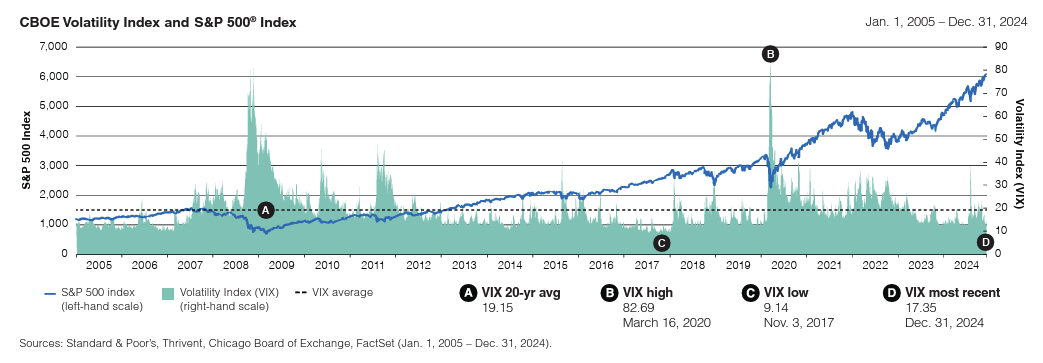The CBOE Volatility Index, or VIX, is a well-known market indicator that gets mentioned in financial headlines and market updates, but what is it, and why should investors care?
Known as the market's "fear gauge," the VIX often spikes during times of uncertainty and investor anxiety. Understanding the VIX can provide valuable insight into market expectations and investor sentiment, helping you to manage investment risk and make more informed decisions.
What is the volatility index (VIX) & what does it measure?
The VIX is a real-time market index that measures the market's expectations for price movement in the next 30 days. Specifically, it gauges anticipated fluctuations in the S&P 500 Index based on options pricing.
Also called the "fear index," the VIX was created in 1993 by the Chicago Board Options Exchange and is formally known as the CBOE Volatility Index.
What the VIX reveals about the market's future
Rather than tracking past market performance, the VIX provides a snapshot of
In short, the VIX tells investors how turbulent the market is expected to be over the next month, making it a valuable tool for understanding sentiment and adjusting portfolio risk.
The chart below illustrates volatility from 2005 to 2024.

How the VIX works to forecast market volatility
Unlike historical volatility, which looks at past market movements, the VIX is forward-looking. It represents implied volatility, or the market's forecast of future movement. This predictive nature makes the VIX a powerful volatility forecasting tool. When investors expect turbulence—whether due to economic data, earnings reports, geopolitical events or policy changes—they often buy more options to hedge their positions. This increased demand raises option prices, which in turn lifts the VIX.
How is the VIX calculated?
The VIX is derived from the prices of the S&P 500 index options. These prices reflect how much investors are willing to pay for protection against market swings. When uncertainty increases, the demand for options increases—and so do their premiums—leading to a higher VIX.
Here's a step-by-step overview of how the VIX is calculated:
- Option prices are selected. The VIX uses a wide range of call and put (buy and sell) options from the S&P 500 that expire in about 30 days. There's a focus on out-of-the-money options, where the strike price (the fixed price at which you can buy or sell the asset underlying the option) is far from the current index level. They are more sensitive to changes in volatility.
- The prices help estimate expected market volatility. The VIX model calculates the implied volatility embedded in the selected options.
- A formula combines the prices to get a percentage. The figures are combined into a weighted average that reflects expected market volatility.
While the actual calculating can seem complicated, no complex math is required to understand the bottom line: Higher option premiums generally indicate a more volatile market outlook, and that's what the VIX is measuring.
Interpreting market volatility: How to read VIX levels
The VIX is expressed in percentage points and represents the expected annualized change in the S&P 500 over the next 30 days. While it doesn't predict market direction, it does signal how volatile the market is likely to be. Here's how to interpret VIX levels:
| VIX level | Market sentiment |
| <20 | Calm |
| 20-30 | Normal/neutral |
| >30 | Elevated stress/anxiety |
The VIX tends to revert to its long-term average over time, known as mean reversion. This means extremely high or low VIX levels don't last forever. Spikes in the VIX are often temporary responses to short-term uncertainty.
Historical examples of VIX spikes include:
- 2008 financial crisis: The VIX surged above 80 during peak panic.
- March 2020 (COVID-19): The index again spiked above 80 amid global uncertainty.
- April 2025: The VIX climbed above 50 following major tariff announcements.
These dramatic increases were short-lived, and the index eventually returned to more typical levels.

Practical uses for the volatility index
The VIX helps investors understand market sentiment when making investment decisions and also can be used to help protect a portfolio from the impact of big market swings.
Can you invest in the VIX?
You can't invest directly in the VIX, but you can gain exposure through financial products tied to it:
- VIX futures. Traded on the CBOE Futures Exchange, these contracts allow investors to bet on or hedge against future volatility.
- VIX ETFs and ETNs. Exchange-traded funds (ETFs) and exchange-traded notes (ETNs) offer a way to track VIX futures.
- VIX options. These contracts allow for more targeted strategies but are complex and typically used by experienced traders.
Several of these products employ leverage and are deemed by regulators to be used only for intra-day trading, not held for longer periods.
How to use the VIX to make better investment decisions
For financial advisors and institutional investors, the VIX is a useful tool to gauge
- Indicating market sentiment. A rising VIX may signal increased caution among investors.
- Influencing diversification strategy. Some advisors may increase defensive holdings when the VIX spikes.
- Making tactical adjustments. Portfolio managers might reduce equity exposure during
high-volatility periods to manage downside risk. - Hedging against market swings. VIX can help inform hedging strategies, especially when paired with other market indicators.
While it's not a crystal ball, the VIX gives investors and market professionals data for making well-informed decisions. But like any metric, it should be considered as part of a broader investment strategy.
Why the VIX matters for investors
Understanding the VIX can help investors stay more grounded and less reactive during a market downturn. It provides a real-time snapshot of investor sentiment and expected market volatility, offering valuable context to guide financial decisions. But it's just one tool in making smart investment decisions for your financial future.
During times of market volatility, it can be especially helpful to get expert advice. Connect with a







